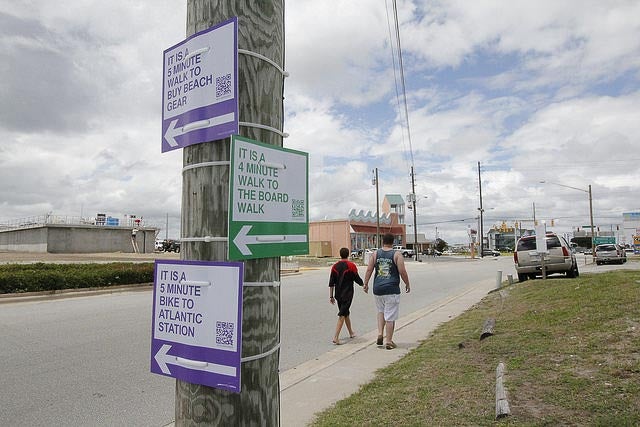It was in 2012 when the colorful signs started popping up around town with simple messages directing pedestrians towards things like shopping districts and other urban amenities - along with a message about how long it would take to walk there.
"It was such a novel and great idea," said Dayton, chair of Raleigh's Bicycle and Pedestrian Advisory Commission. "I remember when it kicked off just how groundbreaking it was."
Today, the group that initially installed 27 guerilla-style signs in Raleigh is now a full-fledged company dubbed Walk [Your City]. And it's gone legit.
While the signs initially posted by company founder Matt Tomasulo in 2012 were illegal - and soon removed by the city officials - Raleigh has now partnered with Walk [Your City] on several pedestrian campaigns around town. And other communities are joining in as well.
"It encourages people to see their city or their part of a community in a way they might not have previously," said Maire Dekle, WYC's chief civic ops and opportunities officer. "For people who already bike and walk a lot, it validates their commitment."
What seems to draw so may people to Walk [Your City] is its simplicity. The signs are inexpensive to produce and easy to install, yet they're eye-catching and offer a compelling message.
WYC's signature product is a simple 12-inch by 12-inch sign printed on corrugated plastic with an arrow pointing walkers to a nearby attraction and an indication of its distance. A QR code printed on the sign links to more information about the destination. And that's pretty much it.
Company officials say the reason the signs work is based, in part, on psychology: people often perceive places to be further away than they really are. On the other hand, the thinking goes, if people know their destination is relatively close by, they'll be more willing to walk there. Crucially, WYC's signs display a destination's distance in minutes - not miles - because it's seen as a measurement that's easier to understand. "It's Not Too Far" is the company's slogan.
Dekle said the company works closely in formalized partnerships with several municipalities including Raleigh and Durham. Through funding from the Knight Foundation, it's working with San Jose and Lexington, Ky. to install signs as well.
Meanwhile, a variety of entities - community groups, business districts and regional health organizations, among others - have chosen a DIY approach, utilizing WYC's "Build A Sign" platform on its website that allows users to easily design signs for their own communities.
The signs cost $19 to $23 each and can be printed and shipped in about a week. That makes one of WYC's biggest draws its affordability. "It's great for cities that have developed a pedestrian plan but don't have a way to make a significant infrastructure investment," Dekle said.
The DIY method also gives communities an easy way to test pedestrian programs before investing heavily in more permanent signs or infrastructure. So far, Dekle said, more than 100 communities on six continents have used the technique.
The signs can serve a variety of functions, but WYC says communities should probably try to design them with a certain goal in mind, whether its increasing physical activity, supporting local businesses, drawing people to historic sites, or fostering "urban discovery".
"We see people coming at it from all different directions," Dekle said. "It just speaks to how people are increasingly recognizing the importance of walkability."
In late 2013, for example, the non-profit Creative Santa Fe led a massive pedestrian campaign that involved installing 150 WYC signs in the city. The effort was designed to connect pedestrians between the city's downtown plaza and the Santa Fe Railyard, an area that includes a park, farmer's market and restaurants and retail.
"They're two of our biggest sites, and it's an easy, pleasant walk," said Katelyn Peer, director of community initiatives at Creative Santa Fe. "But for some reason, people get tripped up."
The signs directed pedestrians between the two districts - as well as to businesses and other points of interest in between. They were part of a broader six-week pedestrian campaign that also included a temporary painted walking path, an ambassador program in which volunteers offered pedestrians directions, and the installation of outdoor seating along the streets to encourage the use of public space.The Santa Fe campaign is over, but it's prompted the city to look at installing more permanent versions of the signs."Walk [Your City] gave us a really good foundation," Peer said. "From there, every community can tweak it as they talk about making it permanent. It's a really good platform for that experimental phase of just getting the ball rolling. "Dayton, of Raleigh's pedestrian commission, said he doesn't think pedestrians necessarily rely on the signs for directions. Instead, he said, they serve mainly to inspire people to walk places they might have previously only driven to.
The company's first "official" project, for example, was a mixed-used development in Raleigh where people frequently drove from destination to destination, even though they're all within the same shopping complex, Dekle said.
"We're a car culture," Dayton said. "(WYC) found a way to sort of break through that noise and get you to think about where you are and how close things are."


